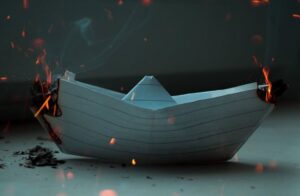By Tom Keeling MIMarEST and Peter Brookes CEng, MIET, affillIIMS. Tom Keeling and peter Brookes are inland waterways-based marine surveyors. Both have run independent consultancy businesses in this sector for many years, specialising in the survey of steel thickness of narrowboats and their hulls.
 Marine surveyors and boat owners are regularly heard to say there is a minimum 4.0mm of hull thickness required at time of survey of a steel narrowboat. Some brokers even publish videos of such information, with some surveyors enforcing it (Whilton Marina, 2012 and 2016). Boaters are subject to it and repair often follows. In a recent article, Geoff Waddington (2021) explains there is confusion in the industry about wastage limits, and consequently acceptable residual hull plate thicknesses, and opinions among surveyors ‘vary wildly’, with some quoting 3mm acceptable minimum plate thickness, others using percentage loss. This short paper explores what a standardised acceptable limit for diminution, and therefore residual steel plate thickness for narrowboats, could be. It describes a variety of methods of calculating the design plate thicknesses (scantlings) and the minimum acceptable residual plate thickness. In doing so, this paper aims to serve as a guide for inland waterways marine surveyors, boat owners, repairers, and insurers alike. Continue reading “Minimum Steel Thickness for Narrowboats: A discussion paper”
Marine surveyors and boat owners are regularly heard to say there is a minimum 4.0mm of hull thickness required at time of survey of a steel narrowboat. Some brokers even publish videos of such information, with some surveyors enforcing it (Whilton Marina, 2012 and 2016). Boaters are subject to it and repair often follows. In a recent article, Geoff Waddington (2021) explains there is confusion in the industry about wastage limits, and consequently acceptable residual hull plate thicknesses, and opinions among surveyors ‘vary wildly’, with some quoting 3mm acceptable minimum plate thickness, others using percentage loss. This short paper explores what a standardised acceptable limit for diminution, and therefore residual steel plate thickness for narrowboats, could be. It describes a variety of methods of calculating the design plate thicknesses (scantlings) and the minimum acceptable residual plate thickness. In doing so, this paper aims to serve as a guide for inland waterways marine surveyors, boat owners, repairers, and insurers alike. Continue reading “Minimum Steel Thickness for Narrowboats: A discussion paper”

 Marine surveyors and boat owners are regularly heard to say there is a minimum 4.0mm of hull thickness required at time of survey of a steel narrowboat. Some brokers even publish videos of such information, with some surveyors enforcing it (Whilton Marina, 2012 and 2016). Boaters are subject to it and repair often follows. In a recent article, Geoff Waddington (2021) explains there is confusion in the industry about wastage limits, and consequently acceptable residual hull plate thicknesses, and opinions among surveyors ‘vary wildly’, with some quoting 3mm acceptable minimum plate thickness, others using percentage loss. This short paper explores what a standardised acceptable limit for diminution, and therefore residual steel plate thickness for narrowboats, could be. It describes a variety of methods of calculating the design plate thicknesses (scantlings) and the minimum acceptable residual plate thickness. In doing so, this paper aims to serve as a guide for inland waterways marine surveyors, boat owners, repairers, and insurers alike.
Marine surveyors and boat owners are regularly heard to say there is a minimum 4.0mm of hull thickness required at time of survey of a steel narrowboat. Some brokers even publish videos of such information, with some surveyors enforcing it (Whilton Marina, 2012 and 2016). Boaters are subject to it and repair often follows. In a recent article, Geoff Waddington (2021) explains there is confusion in the industry about wastage limits, and consequently acceptable residual hull plate thicknesses, and opinions among surveyors ‘vary wildly’, with some quoting 3mm acceptable minimum plate thickness, others using percentage loss. This short paper explores what a standardised acceptable limit for diminution, and therefore residual steel plate thickness for narrowboats, could be. It describes a variety of methods of calculating the design plate thicknesses (scantlings) and the minimum acceptable residual plate thickness. In doing so, this paper aims to serve as a guide for inland waterways marine surveyors, boat owners, repairers, and insurers alike. 





 The marine industry has long relied on the expertise and knowledge of cargo surveyors to ensure the safe and efficient transport of goods across the world’s oceans. In today’s rapidly evolving information age, knowledge and expertise is not just power—it is a strategic asset that drives innovation, growth, and competitive advantage. As marine survey businesses navigate an increasingly complex landscape, the integration of artificial intelligence (AI) has the potential to revolutionise the way knowledge is harnessed, analysed and applied across all industries, and the marine survey industry is no different.
The marine industry has long relied on the expertise and knowledge of cargo surveyors to ensure the safe and efficient transport of goods across the world’s oceans. In today’s rapidly evolving information age, knowledge and expertise is not just power—it is a strategic asset that drives innovation, growth, and competitive advantage. As marine survey businesses navigate an increasingly complex landscape, the integration of artificial intelligence (AI) has the potential to revolutionise the way knowledge is harnessed, analysed and applied across all industries, and the marine survey industry is no different.  There are six different ways in which ships move in the sea, primarily pitching, heaving and rolling.
There are six different ways in which ships move in the sea, primarily pitching, heaving and rolling. 
